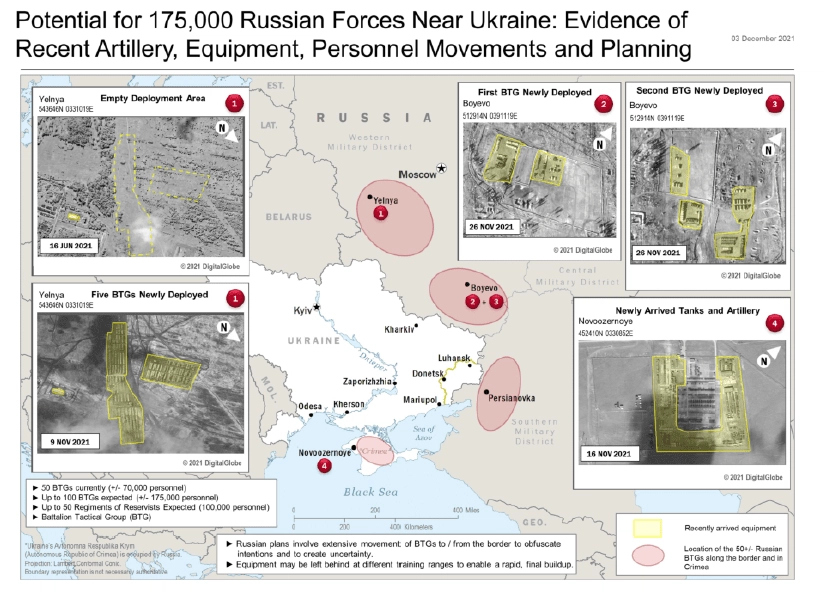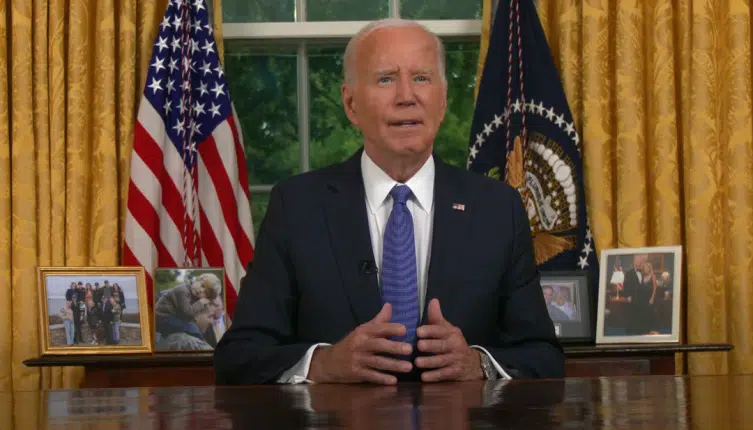Ukrainian Foreign Minister Dmytro Kuleba on Jan. 26 threw cold water on a U.S. intelligence assessment warning of an imminent Russian invasion of Ukraine, telling reporters that Russia’s forces currently are “insufficient for a full-scale offensive” in Ukraine.
“[A]s we speak this number [of Russian forces] is insufficient for a full-scale offensive along the entire Ukrainian border,” Kuleba said, adding, “They also lack some important military indicators and systems to conduct such a large full-scale offensive. We can say 100 times a day invasion is imminent, but this doesn’t change the situation on the ground.”
Funny, that’s not what President Joe Biden has been saying.
To hear Biden tell it, Russia has recently put a massive invasion force on the borders of Ukraine, creating an international crisis, warranting U.S. action of some sort to repel the invasion force before it is too late.
On Jan. 25, Biden warned reporters, “there has been no change in the posture of the Russian forces. There have — and now they are — as you know, they’re along the entire Belarus border… This would be the largest — if he were to move in with all those forces, it’d be the largest invasion since World War Two. It would change the world.”
The Washington Post had similar headlines on Dec. 3, 2021 warning of an imminent Russian invasion, according to a U.S. intelligence assessment: “Russia planning massive military offensive against Ukraine involving 175,000 troops, U.S. intelligence warns.”
The story stated, “U.S. intelligence has found the Kremlin is planning a multi-front offensive as soon as early next year involving up to 175,000 troops, according to U.S. officials and an intelligence document obtained by The Washington Post… The Kremlin has been moving troops toward the border with Ukraine while demanding Washington guarantee that Ukraine will not join NATO and that the alliance will refrain from certain military activities in and around Ukrainian territory.”
Going back a couple of weeks before that, a similar headline can be found from CNBC on Nov. 17, “The world is worried Putin is about to invade Ukraine.” It cited a Nov. 2 press release from the Ukrainian Defense Ministry, translated from Google, stating Russia’s troop levels were at least 90,000: “According to the Central Intelligence Agency of the Ministry of Defense, as of early November 2021, a group of troops (forces) totaling about 90,000 people was concentrated near our border and in the temporarily occupied territories of the Russian Federation.”
But in the Dec. 3 Washington Post report, the U.S. intelligence assessment said it was more like 70,000 Russian troops: “While Ukrainian assessments have said Russia has approximately 94,000 troops near the border, the U.S. map puts the number at 70,000 — but it predicts a buildup to as many as 175,000…”
So, right there, the size of the force is said to be about 70,000 according to the U.S. intelligence assessment in early Dec. 2021. Meaning, in Biden’s words, “if [Putin] were to move in with all those forces” it would not be the largest invasion since World War II — by a long shot. Here’s a few of those.
North Korea’s invasion of South Korea in 1950 was 198,000 troops strong.
The U.S. invasion of North Korea in 1950 in response was 423,000 allied troops, almost entirely U.S. forces.
Israel, the UK and France’s invasion of Egypt in 1956 during the Suez Canal crisis was 254,000 troops strong.
The U.S. presence in South Vietnam in the 1960s was more than 500,000 strong at the peak of the war.
The USSR’s invasion of Afghanistan in 1979 was 115,000 troops strong.
The U.S. invasion of Iraq in 1991 was 956,000 troops strong from 34 countries, including 700,000 U.S. forces, who were responsible for liberating Kuwait, Saudi Arabia and then driving Iraqi forces back into Iraq.
The U.S. invasion of Iraq in 2003 was 300,000 allied forces strong.
Even if one generously spots Russia another 30,000 troops, bringing the number up to 100,000 for a potential invasion, or even the full 175,000 reported in the assessment, the force would still be nowhere close to matching some of these other, much larger conflicts. Why is Biden exaggerating?
Here, the country that’s supposed to be invaded, Ukraine, is saying that the number of Russian forces currently in theater are not considered an invasion force because they are “insufficient for a full-scale offensive.” The U.S. and its prospective ally, Ukraine, are not on the same page. Maybe they’re not as worried as we are.
Perhaps that is because Russia has had tens of thousands of troops on Ukraine’s border based on public reporting since at least 2014 after Russia annexed Crimea from Ukraine. The U.S. and Europe have imposed economic and other sanctions against Russia since.
In April 2014, CNN reported, “What do we know about Russia’s troop buildup on Ukraine’s border?” At the time, the troop estimates were said to be “as many as 40,000 troops near its western border with Ukraine, two U.S. officials said last week,” according to the report.
On May 28, 2015, Reuters reported, “Russia masses heavy firepower on border with Ukraine,” noting, “Russia’s army is massing troops and hundreds of pieces of weaponry including mobile rocket launchers, tanks and artillery at a makeshift base near the border with Ukraine, a Reuters reporter saw this week.”
By 2016, the number of Russian troops on the border had risen to 55,000, according to UNIAN: “Ukrainian Defense Ministry: 55,000 Russian troops massing near Ukraine.”
On Sept. 13, 2017, the Military Times’ Todd South reported in “What’s Putin up to? The Russian military buildup in Europe raises tension” that the overall strength of the Russia force along the Ukrainian border has been as high as 150,000 since the war began. South wrote, “Russians moved an estimated 150,000 troops along Ukraine’s eastern border within days of the end of the 2014 Sochi Olympics as a cover to position forces in Crimea, which they seized despite international condemnation.”
In 2018, then-Ukrainian President Petro Poroshenko warned Sky News that Russian tanks were massing on Ukraine’s borders: “Russian tanks massing on Ukraine’s border, president tells Sky News”.
In 2019, UNIAN reported, “Ukraine beefs up air defense amid massing of Russian troops near Ukrainian borders”.
In 2020, UNIAN reported, “Russia reportedly massing weapons 60 km from Ukraine border”.
And so forth. Russia has been staging tens of thousands of troops on its borders for years, including but not limited to its borders with Ukraine. That in itself does not appear unusual. So, what’s changed?
According to the unclassified one-page U.S. intelligence assessment, a copy of which was published by the New York Times, as of Dec. 3, 2021, there were 50 Russian Battalion Tactical Groups with plus or minus 70,000 troops. Up to 100 Battalion Tactical Groups are expected with up to 175,000 troops, plus or minus, but that is just a projection.
In other words, it’s a military scenario, and perhaps a highly dubious one if Ukraine believes the current force is not even adequate to mount an invasion.
And apparently Putin’s intentions are entirely a question mark. In Biden’s own words, nobody knows what Putin actually wants, “I don’t think even his people know for certain what he’s going to do.”
Let that sink in. We’re risking a direct conflict with Russia in Ukraine, which could mean nuclear war, accidental or otherwise, over a major escalation that might happen, and in which President Biden is admitting he doesn’t really know what Moscow’s intentions are.
Again, compare that to Washington Post’s original headline: “Russia planning massive military offensive against Ukraine involving 175,000 troops, U.S. intelligence warns.”
How good is our intelligence? Remember weapons of mass destruction in Iraq. Remember the Russiagate hoax. And so forth. The American people have been fooled before.
Now, it appears that Russia’s troops on its borders with Ukraine are nothing new, they’ve been there for years, and Ukrainian leaders are publicly questioning Washington’s narrative that it’s an imminent invasion force. They’re tapping on the brakes. But perhaps something really has changed. If so, then President Biden should lay out this intelligence for the American people. So far, Biden hasn’t made the case.
Robert Romano is the Vice President of Public Policy at Americans for Limited Government Foundation.
A version of this article appeared at algresearch.org.








